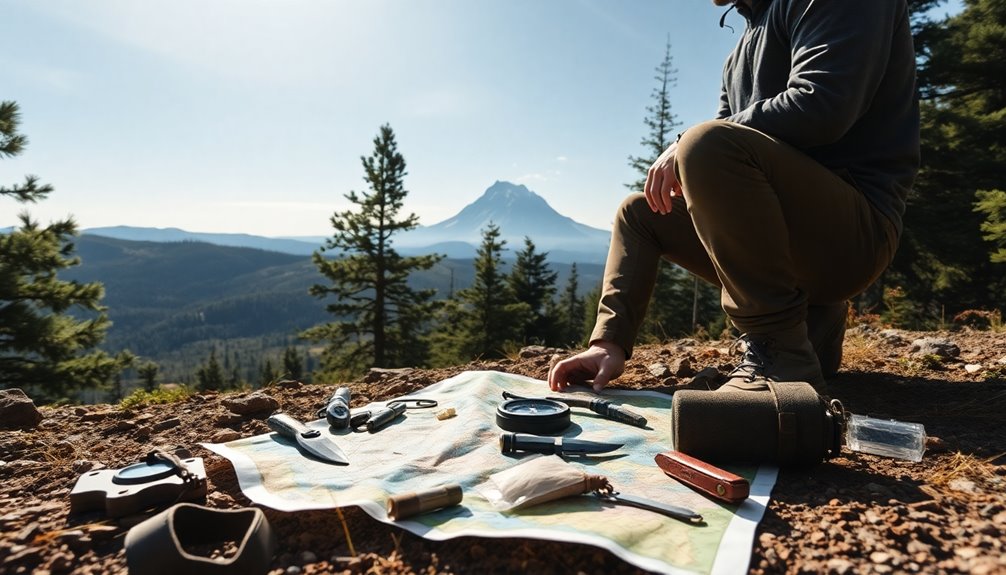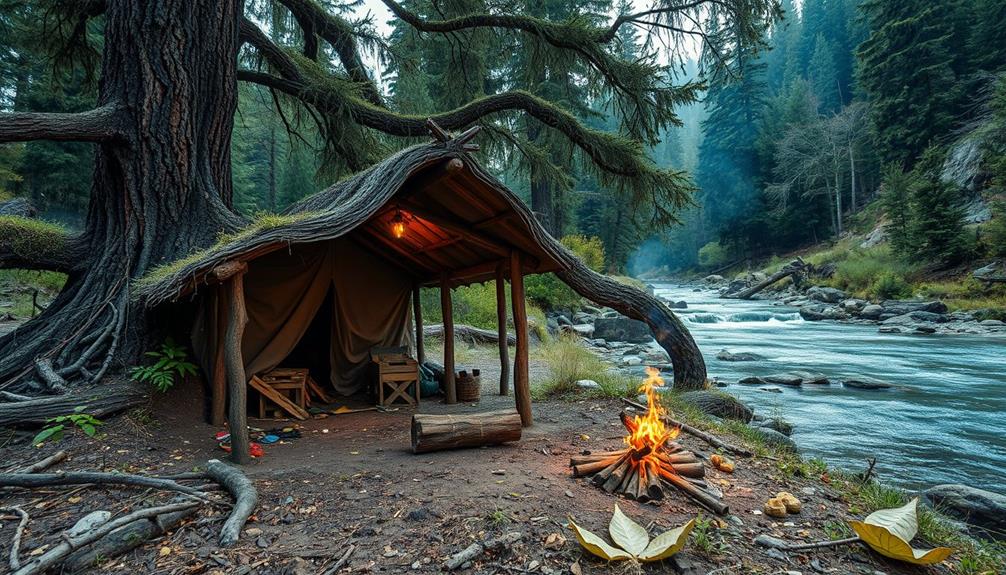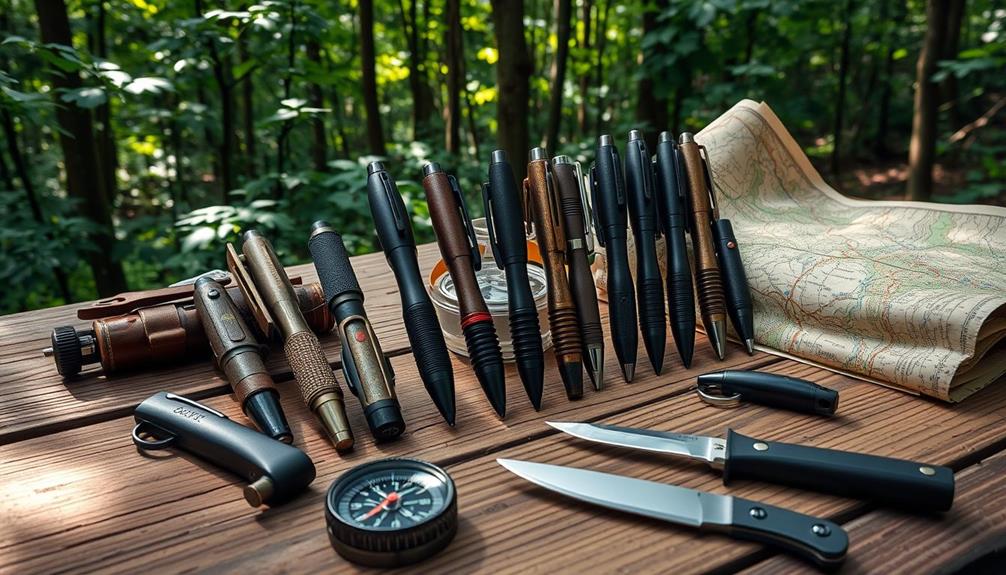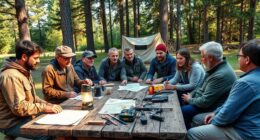In outdoor survival, you can't afford to forget these five essential rules. First, prioritize preparation and planning by evaluating risks, mapping routes, and establishing emergency contacts. Next, master navigation techniques using maps and compasses to find your way. For shelter, choose a proper location and construct a weatherproof haven. Water is vital, so procure and purify it with natural materials or boiling methods. Finally, learn how to start and manage a fire safely, especially in wet conditions. These fundamental skills can save your life, and there's more to explore about each one waiting for you!
Key Takeaways
- Conduct a thorough risk assessment to identify hazards and plan for environmental challenges before heading outdoors.
- Master navigation techniques, including map reading, compass use, and terrain association to avoid getting lost.
- Choose appropriate shelter locations that provide protection from the elements and hazards while ensuring comfort.
- Secure clean water by utilizing natural indicators, collecting rainwater, and purifying it through boiling or filters.
- Learn reliable fire-starting methods and maintain fire safety to provide warmth, cooking, and protection in survival situations.
Preparation and Planning

When you head out into the great outdoors, you need to gear up with thorough preparation and planning to guarantee everyone's safety. Start by conducting a detailed risk assessment to identify potential hazards. Consider environmental factors like terrain, weather, and wildlife. You also need to evaluate your group's skills and experience levels, making sure everyone can handle the challenges ahead.
Next, assess the availability of resources and emergency services in the area. It’s important to know where help can be found if needed. Review historical data on common hazards to prepare for the unexpected. Additionally, remember that clear communication during emergencies can significantly enhance your group’s response. Having a well-stocked wilderness survival kit will further ensure you are equipped for potential challenges. In your kit, consider including multi-functional gear that can serve multiple purposes to save space and weight. Wilderness survival experts recommend that you also familiarize yourself with basic first aid and medical training. In addition to resources and emergency services, it’s crucial to have a solid understanding of the surrounding environment and potential threats. By staying informed and prepared, you can better prevent and address any emergencies that may arise while enjoying the great outdoors.
Mapping out evacuation routes is another essential step. Identify the safest paths from your campsite and designate meeting locations outside the area. Make sure every group member knows these routes and practice the plan regularly. Appoint a leader to coordinate actions during emergencies.
Establish emergency contacts, including local authorities and medical services, and confirm everyone has access to this information. Carry reliable communication devices like phones or radios. Assign specific roles to group members for tasks like first aid and equipment management, making sure everyone knows their responsibilities. With thorough preparation, you'll be ready for whatever nature throws your way.
Navigation Techniques

Maneuvering the wilderness requires a solid grasp of various techniques to guarantee you stay on course and reach your destination safely. Start by mastering map reading. Learn to interpret contour lines, symbols, scales, and the legend key. Always orient your map by aligning it with your facing direction, using a compass or natural landmarks. Plot your routes wisely, considering terrain difficulty, distance, and water sources.
Next, familiarize yourself with your compass. Understand its parts and how to take accurate bearings to your destination. Don't forget to adjust for declination, as this difference between magnetic north and true north can lead you astray. Use triangulation by taking bearings from at least two landmarks to pinpoint your location. Additionally, practicing terrain association regularly will help you build confidence in navigating through various landscapes.
Terrain association is essential too. Match features on your map with those in your surroundings, and be keen on recognizing prominent landmarks. Use visual cues like tree lines and rock formations for guidance.
Shelter and Protection

In the wilderness, finding a suitable shelter is essential for your survival and comfort. Start by selecting a flat area with good drainage, away from water sources to avoid flooding. Look for a spot protected from wind and rain, steering clear of dense vegetation and steep terrain, which can pose hazards like landslides. Additionally, it's important to assess the terrain for signs of moisture and runoff before settling on a location.
When constructing your shelter, consider options like lean-tos, debris shelters, or A-frame designs. Lean-tos are easy to build between trees or against rocks, while debris shelters use fallen branches to conserve energy. Make certain you elevate the floor a few inches off the ground to retain body heat, and create a barrier with pine needles or leaves to stay dry.
Use natural materials like logs and leaves to cover the frame completely. Insulate the inside with layers of grass or hay for added warmth. Keep your shelter weatherproofed and clean, guaranteeing proper ventilation to avoid condensation. If you need to, signal for help using bright clothing or reflective items. Remember, a well-constructed shelter not only protects you from the elements but also enhances your chances of survival in the wild.
Water Procurement and Purification

Surviving in the wilderness means securing not just shelter but also a reliable source of water. Water is essential for your survival, so knowing how to find and purify it is vital. Access to clean water sources is crucial in ensuring your health and maintaining bodily functions.
Methods for Collecting Water
| Method | Description |
|---|---|
| Using Containers | Carry clean water bottles or canteens to transport water. |
| Natural Materials | Utilize large leaves or hollowed tree trunks to collect rainwater. |
| Improvised Methods | Fashion a tarp or plastic sheet to catch rainwater. |
| Observing Natural Indicators | Look for green vegetation and animal tracks indicating water sources. |
Techniques for Purifying Water
To guarantee the water you collect is safe, use these purification methods:
- Boiling: Boil water for at least five minutes to kill harmful microorganisms.
- Water Filter: Create a simple filter using layers of sand, charcoal, and gravel.
- Purification Tablets: Follow instructions for using tablets to purify water quickly.
Fire Starting and Management

Mastering fire starting and management is essential for anyone venturing into the wilderness. A reliable fire can provide warmth, cook food, and purify water. Start with effective methods like flint and steel, which works well even in wet conditions. Simply scrape a high carbon steel striker down a ferrocerium rod to create sparks that can ignite your tinder.
If you're feeling adventurous, try the bow drill technique. It requires practice, but it's less physically demanding than the hand drill. Once you've got an ember, transfer it to your tinder for a successful fire.
When building your fire, begin with tinder—like wood shavings or twigs—and add kindling as it catches. Arrange larger logs in a "star fire" configuration for best heat. Always prioritize safety by building your fire away from flammable vegetation and keeping water nearby. Fire building is a core skill in bushcraft, ensuring you can maintain warmth and safety in the wilderness.
Frequently Asked Questions
What Should I Wear for Outdoor Survival Outings?
When you're heading out for outdoor survival outings, focus on layering your clothing. Start with a moisture-wicking base layer, then add an insulating middle layer like fleece, and finish with a waterproof outer layer. Choose durable footwear, like waterproof boots, and pack thick wool socks for warmth. Don't forget a hat and gloves to protect against the elements. Staying adaptable and comfortable is key to successfully steering through any outdoor adventure.
How Do I Signal for Help if Lost?
When you're lost, signaling for help is like sending out a lighthouse beam in a stormy sea. First, use a whistle, producing three short blasts; it's energy-efficient and carries far. If you've got bright clothing, wave it to catch attention. Create a large "SOS" on the ground using rocks or logs. If possible, use your phone or a GPS locator to reach out, ensuring your message finds its way home.
What Are the Best Foods to Pack for Survival?
When packing for survival, focus on nutrient-dense foods that are lightweight and easy to prepare. Canned beans, tuna, and peanut butter provide protein, while whole-grain crackers and dried fruits offer carbohydrates. Don't forget fats like nuts and jerky. Choose dehydrated meals for compact options and ready-to-eat foods that require minimal water. This way, you'll guarantee you have the energy and nutrients needed to stay strong in challenging situations.
How Can I Stay Safe From Wildlife Encounters?
How can you stay safe from wildlife encounters? First, always maintain a safe distance from animals; keep at least 30 meters from deer and 100 meters from bears. Carry bear spray and know how to use it. Stay alert and make noise to let animals know you're there. If you encounter wildlife, stay calm and make yourself appear larger. Remember, it's essential to respect their space and avoid surprising them.
What First Aid Supplies Should I Bring on a Trip?
When planning a trip, you should pack essential first aid supplies to handle minor injuries. Bring antiseptic wipes, antibacterial ointment, and assorted adhesive bandages for cuts. Include blister treatment and insect sting relief. Don't forget wraps, splints, and gauze for more serious injuries. Medications like aspirin, antihistamines, and injectable epinephrine are vital for allergic reactions. Finally, tools like tweezers and paramedic shears can help manage wounds effectively. Stay prepared!
Conclusion
So, you're all set for your outdoor adventure, right? You've memorized the five rules you can't afford to forget—but let's be real. Who needs a map when you can just wander aimlessly? And who cares about purifying water when you can drink straight from the stream? Fire? Pfft, that's for campfire stories. Just remember, if you find yourself lost, wet, and cold, at least you'll have a great story to tell—if you make it back!










